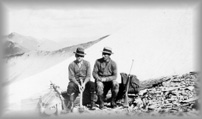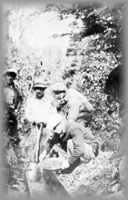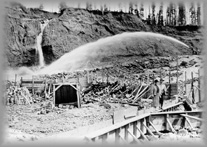 |
|
|

Gold mining operations may be carried out by either placer mining or lode mining. Lode mining is also called hard rock mining.
Two placer prospectors on a mountain, wpH126
Originally, all gold is deposited in a lode or vein filled with mineral in the rock, such as the gold-rich veins discovered in Cow Mountain. When these lodes are disintegrated by natural erosion, such as water flowing over the rock, placer gold is the result - the deposit of loose surface soil or gravel that contains gold.
Extremely rare crystalline gold occurs in both the placer streams and the lode deposits. Given the earlier success of placer gold mines in the Cariboo, prospectors were obliged to search for the local source of the placer gold in hidden lodes beneath the surface of the earth.
The process of placer mining involves filling a pan with the crushed ore to separate the gold. This could be done individually by one prospector on their own.
The process of lode mining involves the labour of many miners working together to extract the gold from tunnels in a mountain or the earth.
The placer gold mines were a success in the Cariboo Gold Rush and started up towns like Barkerville, Richfield, Camerontown and Marysville during the 1860s.
New prospectors, like Fred Wells were compelled to search for the source of this placer gold in the Cariboo - the 'Motherlode'. Coarse nuggets containing fragments of vein quartz were discovered from Lowhee Creek and elsewhere so it was probable there was a local source or lode where the placers originated from, waiting to be discovered nearby.
The Process | Lode vs. Placer | Two Companies | Mining Strikes | Profile of a Miner | Home | Meet the Team | Site Map
Last updated: September 9, 2000



